Event Conference
Protecting Environmental Defenders | HRC52 Side Event
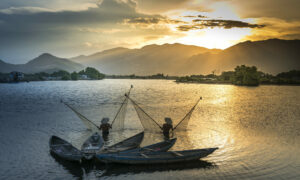
20 Mar 2023
11:00–12:00
Venue: Palais des Nations, Room XXII & Online | YouTube
Organization: Geneva Roadmap 40/11 for Environmental Human Rights Defenders, Geneva Environment Network
This side event to the 52nd session of the Human Rights Council (HRC52) discussed the steps made since the launch of the "Geneva Roadmap 40/11" in 2020 in the protection of environmental defenders and identify objectives to come.

About this Event
In view of the current increase of threats and attacks on people engaged in the protection of the environment, the Human Rights Council resolution 40/11 on the protection of environmental human rights defenders, adopted on 19 March 2019, requires a strong implementation follow-up.
The “Geneva Roadmap 40/11”, initiated by the environmental defenders’ meeting in Geneva on 25-27 February 2020, aims at fully utilizing the opportunity offered by the Human Rights Council sessions to promote exchanges between States, researchers and human rights and environmental defenders organizations. It can take stock of current progress and identify objectives that will reinforce the safe space needed for individuals and organizations to act for the protection of the environment.
The COVID-19 pandemic limited the development of this initiative due to the restrictions that started in March 2020, just after the first meeting. With restrictions lifted in most countries, the initiative can now resume its original trajectory. The 52nd session of the Human Rights Council, this March 2023, marks the 25th anniversary of the UN Declaration on Human Rights Defenders, a founding moment. In this perspective, the “Geneva Roadmap 40/11” proposes to take stock of the steps made since 2020 in the protection of environmental defenders and to identify objectives to come, ensuring the implementation of the Council’s resolution 40/11.
Speakers
By order of intervention.
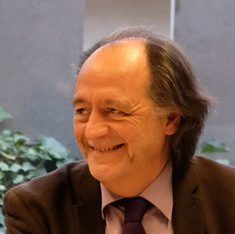
Yves LADOR
Representative of Earthjustice to the United Nations in Geneva

Tawonga CHIHANA
Coordinator, African Environmental Defenders Initiative, Natural Justice
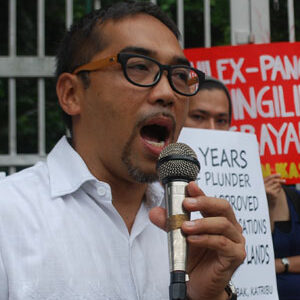
Clemente BAUTISTA
International Network Officer, Kalikasan People's Network for the Environment & Asia Pacific Network of Environment Defenders
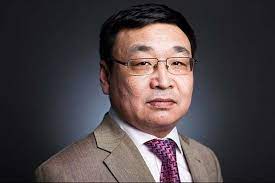
Vadim NI
Chair, Board of Trustees, Socio-Ecological Fund
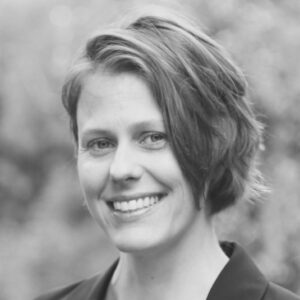
Summer KERN
NGO Observer to the Bureau of the Aarhus Convention, Justice and Environment

Vanessa TORRES
Deputy Director, Asociación Ambiente y Sociedad
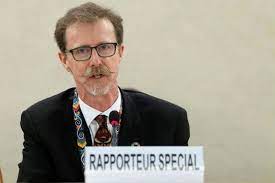
David BOYD
UN Special Rapporteur on human rights and the environment

Michel FORST
Special Rapporteur of the Aarhus Convention on Environmental Defenders

Peter LARSEN
Senior Lecturer and Associate Researcher, at the Environmental Governance and Territorial Development Institute and Department of Sociology, University of Geneva

Eva HERSHAW
Data and Land Monitoring Lead, International Land Coalition
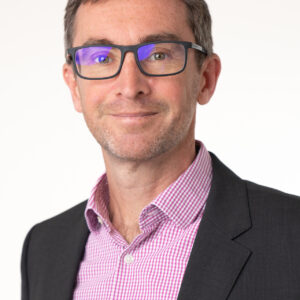
Phil LYNCH
Executive Director, International Service for Human Rights

Soo-Young HWANG
Legal Officer, UN Environment Programme
Highlights
Video
Live on facebook part 1 and 2
Summary
To be continued.
Welcome and Introduction
Voices from the Field
Tawonga CHIHANA | Coordinator, African Environmental Defenders Initiative, Natural Justice
Situation in Africa
- The African Environmental Defenders Initiative at Natural Justice was established in 2019, it works to strengthen the rights of environmental defenders across Africa and advocate for their legal protection.
- Over the last couple of years, we have seen a rise in attacks on environmental defenders in Africa. This data is still largely sporadic and nominal when compared to data from South America or Asia, for example.
- This raises questions because we all understand Africa to be the next frontier for extractivism, referring to oil and gas extraction, fossil fuel expansion, mining. The expectation is that the current numbers we have are not an accurate reflection of the situation of environmental and land defenders in Africa.
- To provide more context, Africa is growing, it is projected that Nigeria will be the third most populous country by 2050 behind India and China. This underpins the discussion around the struggle for resources.
- Environmental and land defenders are under understandably concerned about the impact of these projects on communities. We have heard from host communities reporting cases of poor health, destruction of biodiversity, environmental degradation, and social unrest, as seen in countries such as the Democratic Republic of Congo, the Niger Delta, Angola and many more African countries.
- Even though 35 out of 54 countries in Africa, close to about 70 percent, have ratified and recognized the right to a clean and healthy environment, very little strides have been made towards implementation and enforcement. This could be attributed to an array of factors which include lack of political will, limited access to information and environmental rights, limited access to justice, corporate capture and corruption among government and political actors and many more challenges.
Conventions and landmark resolutions to learn from
- On a much more positive note, there have been a few recent landmark resolutions and Conventions made over the last few years that could potentially motivate Africa as a continent to adopt regional and national legal frameworks that enhance the protection of environmental defenders.
- The primary one is the African Charter on Human and People’s Rights. This is the first regional human rights treaty in Africa to recognize the right to a clean and healthy environment, which has been complemented by the revised African Convention on the Conservation of Nature and Natural Resources which provides for access to information, public participation and legal recourse for environment action.
- At the international and global level, we look at the Escazú Agreement, which Africa can draw lessons and insights from and to inform our own regional environmental rights agreement.
- Quite recently, COP15 presented an opportunity for civil society to provide recommendations to address issues faced by environmental human rights defenders. This led to the recognition of environmental human rights defenders under Target 22 of the Montreal-Kunming Biodiversity Framework in December 2022.
- The UNECE Convention which provides for a special the first Special Rapporteur on environmental defenders, which is something that Africa can learn insights from in informing Africa’s own environmental rights agreement.
What are the next possible steps?
- How do we strike a balance between the right development and the right to a clean and healthy environment? Where is the starting point?
- There are Conventions that provide for this balance. We look at the Rio Declaration on Environment and Development, at the 2030 Agenda on Sustainable Development, at the Framework Principles for Human rights and the Environment.
- Each one of these conventions affirms that the right to a clean, healthy and sustainable environment is necessary for the full enjoyment of human rights. It includes the protection of the environment as a condition for development: that development cannot happen without first ensuring that the right to a clean, healthy and sustainable environment is upheld.
Within the context of the Geneva Roadmap 40/11, what is the next step for Africa?
- There’s been a discussion around an environmental rights agreement for Africa, and there is currently a movement of more than 40 African and Global Civil Society members led by Allied that are really trying to build momentum for the ratification of the legally binding agreement or environmental rights in Africa.
- We have seen from the Escazú Agreement that binding agreements can help States fully realize the right to a healthy environment by facilitating and creating accountability mechanisms and strengthening legal protectionand redress channels for environmental defenders.
- As a starting point, we as civil society need to mobilize support for an environmental rights treaty at the regional level. How do we mobilize the support? Where do we begin? This lies in
- a strengthened civic space that advocates for and pushes for the adoption of an environmental rights agreement,
- identifying and mapping governments and its national proponents,
- identifying champions and leaders and leveraging their support to engage other governments,
- and lastly ensuring that UN Special Procedures advocate governments in Africa to adopt an environmental rights agreement.
- The Geneva Roadmap has laid the groundwork and the foundation to really drive a discussion around the adoption of environmental rights agreement in Africa.
Clemente BAUTISTA | International Network Officer, Kalikasan People’s Network for the Environment & Asia Pacific Network of Environment Defenders
- The Philippines and India were identified as the 3rd and 10th most dangerous country in the world among environmental defenders, respectively.
- In the Philippines, the Kalikasan People’s Network for the Environment monitored from 2017 to 2022 that there were at least 196 environmental defenders killed and another 20,000 more victimized by different forms of human rights violation under the Duterte Administration.
- We are also seeing a new scheme of using modern warfare such as aerial bombing and strikes against communities in 2022. We monitored total of 14 aerial bombings. which displaced tens of thousands of indigenous peoples and peasants. This is on top of other violations, such as harassments, tagging as terrorists, trumped up charges of illegal arrests and detention that happened after President Marcos won the presidential election in May 2022 election. A total of eight cases of violations which victimized 120 environmental and land defenders were recorded.
ASEAN situation
- With our ASEAN neighbors, the situation is almost the same. Myanmar is still under military rule. Thailand was also under military rule from 2014 to 2019. In West Papua, there is a massive militarization and conflict. These are the common observations in the regions that we have observed in the Asia Pacific Network of Environmental Defenders (APNED).
- First, environmental defenders in Asia are often subjected to violence threats and intimidation from governments, corporations and powerful actors.
- Red tagging is used in demonizing environmental defenders as terrorists, governments often use repressive laws to silence environmental defenders and prevent them from organizing and speaking out against environmental degradation. These laws can be used to arrest and imprison defenders, shut down protests and demonstration, and restrict freedom of speech and assembly.
- Third, environmental defenders in Asia is often face obstacles when seeking justice. The justice system in the region is slow, corrupt, and biased towards a powerful actors, governments and corporations.
- Proliferation of resource extraction and land grabbing projects and policies. Many environmental Defenders work to protect their land and natural resources from privatization and exploitation by corporations and governments.
- Fifth, militarization. The guise of counter-insurgency or anti-terrorism are being used to push destructive projects projects like big mining commercial logging, mega dams, agro plantations and the like. In the process, environmental defenders who are in the forefront in protecting this natural landscape and communities and in conserving these natural resources are targeted and victimized.
Landmarks and next steps
- There are however recent landmarks. In the Philippines, we were able to have small victories were contributed to the following:
- First, we monitored a big drop of cases of killings among environmental defenders to 19 cases in 2021. But this remains far too many and unacceptable.
- Second, we were able to push the United Nations to make a report in the human rights situation in the Philippines. This obliged the Philippine government to engage the international community in discussing the human rights situation.
- Third, after dragging their feet, the Philippine government started to allow last year the official visit of UN Special Rapporteurs into the country.
- Fourth, in the legislative arena, recently the Human Rights Defenders Protection Bill and the People’s New Green Deal was approved at the Committee level at the House of Representatives. These bills contain security provisions for the protection of human rights of environmental defenders.
- Fifth, last year, there was a judicial ruling by the Philippine Regional Trial Court that declared that the organizations Communist Party of the Philippines and the New People’s Army which are involved in the local conflict or civil war were not terrorists but are rebels who have ideas and are aspiring for an alternative society. This decision is legally important to activists and environmental defenders who are being red tagged by the Philippine government as rebels or or being labeled as terrorists.
- The UN can do more and other international institutions can help us environmental defenders in the Philippines and in the region.
- The UN should detail and put more probation in its resolution 40/11 that recognize the contribution of the defenders to the enjoyment of human rights, environmental protection and sustainable environment.
- The UN particularly the Human Rights Council and the Special Mandate Holders could do a series of regional reports on the state of human rights particularly in Latin America, Africa and Asia.
- The UN should further strengthen its monitoring and enforcement of international humanitarian law particularly in countries where there’s growing local conflicts related to natural resource extraction and environmental plunder, like in the Philippines, Myanmar, India, Colombia, Peru and the like.
- We hope we could work together pushing a regional binding agreement in Asia that will strongly protect the rights of the defenders, communities and nations to a clean, healthy and sustainable environment. Thank you and happy anniversary to all on the 25th year of the UN Declaration on human rights. Defend our rights, defend our defenders.
Vadim NI | Chair, Board of Trustees, Socio-Ecological Fund
In 2017 and 2019, Socio-Ecological Fund together with Crude Accountability published reports on reprisals against environmental defenders in the former Soviet Union countries and the United States.
I’m going to present the most recent cases including the one that occurred recently to my colleagues in Atyrau, the oil capital of Kazakhstan.
- On 13 February, local colleagues received the claim from a private company for Facebook publication of conducted public hearings.
- One publication consists consists of 11 photos from the public hearings in short, introductory remarks and what the subject matter of the event is. The second one included a number of remarks challenging environmental integrity of the company with just one negative statement that the company was reasonably disgraced. The company claims they can initiate a criminal prosecution against the environmental defenders for disseminating allegedly and deliberately false information.
- The relevant provision of the Criminal Court provides a number of alternative sanctions for such offenses including restriction or deprivation of liberty for up to three years. It’s a very intimidating case from the companies for very innocent claims and activities.
- During the last months, I participated in the election campaign as a candidate to the Lower Chamber of the Parliament. In that capacity, I had a live stream discussion of that case and tried to explain to the company what was wrong with the private prosecution of environmental defenders, including what might be the consequences under Art.3, Par.8 of the Aarhus Convention. Hopefully it will stop the company from taking further steps to penalize the environmental defenders.
- Our organization is providing legal assistance to the environmental defenders; fingers crossed, everything will be fine with our colleagues.
Another direction of the current activities of our organization is on environmental defenders in Russia.
- It’s not part of Central Asia, but we experienced some consequences of their appraisals in the Russia last year. Arshak Makichyan, a climate activist from Russia, was deprived the Russian citizenship for an alleged a minor mistake made by his parents many years ago when they obtained Russian citizenship.
- Many Russian colleagues are under imminent threat to be determined as foreign agents. We don’t understand anymore the reasons behind the determination as foreign agents.
- The most recent case you may know about it is with WWF Russia. We’re trying to do our best by disseminating this information and by assisting a number of colleagues to move to and settle in Kazakhstan.
Summer KERN | NGO Observer to the Bureau of the Aarhus Convention, Justice and Environment
Video to follow.
Vanessa TORRES | Deputy Director, Asociación Ambiente y Sociedad
The environmental NGO, Asociación Ambiente y Sociedad in Colombia works to protect the environment with a human rights perspective. Our work is focused on the Pacific and Amazon regions mainly in the foothills of Capital Putumayo Department and the Sabana de Bogotá.
- According to the Global Witness Report, at least 1733 environmental and land defenders have been killed around the world in the last decade. More than two-thirds of the murders took place in Latin America. 200 defenders were killed in 2021.
- Defenders are being targeted by the government companies and other non-state actors with violence, intimidation and criminalization in Latin America. Colombia topped the ranking in 2020, and Mexico in 2021. Between 2012 and 2021, Latin American countries accounted for 7 of the 10 deadliest countries for environmental activists.
- Brazil registered the highest number of homicides, and Colombia came in second place. Colombia continues to have one of the highest murder rates in the world. At least 30 environmental defenders were killed in 2022. We are in the 6th year of implementation of the peace agreement.
- Unfortunately, social and environmental conflicts have increased. The principal reasons: land tenure, advance of destructive frontier, and forced displacement. The implementation of sustainable economies at the local level is a high risk activity in Colombia.
Colombia and the Escazú Agreement
- 2022 region is an important year for Colombia, progressivist is the predominant political vision. Gustavo Petro’s victory as president of Colombia marks the beginning of an environmental and human rights agenda in which the protection of environmental defenders becomes a priority.
- Different organizations in Colombia have promoted the ratification of the Escazú Agreement since 2018. We participated in the negotiation process of the agreement as part of the public from 2014 to 2018.
- From 2018 to 2022, we promoted the ratification of the Agreement in Congress. This process ended in October 2022. We are currently waiting for the review of the content of the agreement by the Constitutional Court. The country will prepare for the implementation phase.
- The ratification and implementation of the agreement is key to an effective regulatory framework that prevents conflict situation and for the recognition of the role of the environmental defenders as a fundamental piece in the process of conservation and restoration of strategic ecosystems.
- The implementation of the Escazú Agreement is an opportunity for the Parties. The creation of a protection route at the regional level in the Annual Defenders Forum is a joint constructive scenario, an example for the planet.
- Next month in April, we will celebrate the second COP. For us, it is an opportunity to strengthen the role of of the public in the agreement.
- We cannot forget that we the citizens are the heart of the Escazú Agreement.
Finally, the definition of the environmental defenders established in Resolution 40/11 is essential for the protection of indigenous people, afro-descendants, farmer communities in our country and in the region. The recognition of the differential impact of climate change is the key to protecting strategic ecosystems.
Overviews
David BOYD | UN Special Rapporteur on human rights and the environment
We’re in the midst of a planetary environmental crisis. The world urgently needs more people to stand up and fight for the protection and restoration of the air, water, soil biodiversity and climate that we all depend on.
- Ultimately, all human rights depend on a healthy planet. So we need more defenders of the right to a healthy environment, indigenous rights, the rights of the child, and other human rights.
- Yet in far too many States, standing up for the environment, for clean air and water, healthy biodiversity, healthy oceans, and a safe climate is a dangerous activity. We all know the statistics: more than 200 documented murders of environmental human rights defenders every year, and that’s just the tip of the iceberg of intimidation, violence, criminalization and harassment.
- Women and girls are amazing environmental human rights defenders but are vulnerable to gender-based violence. This situation cannot continue.
Environmental human rights defenders need protection and they need it now.
- We have the UN Declaration on Human Rights Defenders.
- We have the Human Rights Council Resolution 40/11 on environmental human rights defenders.
- We have the Escazú Agreement with its pioneering obligations to protect human rights defenders.
- We have the new Special Rapporteur for environmental human rights defenders established by Parties to the Aarhus Convention.
- A growing number of States have national protection mechanisms in place to safeguard defenders.
But none of these words are sufficient. They are tools and tools need people to be useful — people with the knowledge, courage and capacity to use them.
- We need the immediate implementation of existing protection mechanisms and the enforcement of existing laws. We need to use human rights-based approaches to conservation, climate action, and preventing pollution.
- We need governments to pass and implement laws recognizing the title and rights of indigenous peoples, as well as legally guaranteeing their right to free, prior and informed consent before activities are approved in their territories of life.
- We need to build capacity, reduce corruption and strengthen the rule of law. When I speak to environmental human rights defenders, they often tell me it’s difficult for them to get access to help.
- They need help to build networks to create connections with lawyers, scientists, funders and other allies. There is strength in numbers. They need help to harness the power of new digital tools. They need resources.
- We also need to prevent the socio-environmental conflicts that are the root cause of the persecution of environmental human rights defenders. That means transforming our economies, replacing fossil fuels with renewables, replacing industrial agriculture with agroecology, and ending the exploitative mentality of extractivism.
- We need a new legally binding treaty to govern the conduct of multinational corporations because the UN Guiding Principles on Business and Human Rights are too weak.
- Finally, we need to put human rights at the heart of all climate and environmental actions. Far too often conservation actions have violated human rights evicting people from their homes and communities criminalizing traditional lifestyles, and in extreme cases murdering indigenous peoples and members of local communities for simply trying to exercise and defend their rights.
Surely we can all agree that in the 21st century this is completely unacceptable. We need to protect the heroic individuals and communities working so hard to safeguard this beautiful blue-green planet that we are all so lucky to call home.
I’d like to extend my personal gratitude to all environmental human rights defenders for the vital work that you’re doing on behalf of your families, your communities, and the beautiful planet Earth. Thank you all, and take care.
Michel FORST | Special Rapporteur of the Aarhus Convention on Environmental Defenders
The Geneva Roadmap is a very important initiative to follow up on the implementation of resolution 40/11 on the protection of environmental defenders. I welcome this panel in order to look at what has been done since March 2020, to better protect those who put their lives at risk, to preserve the future of our planet.
Protecting defenders under the Aarhus Convention
- One important decision has been the decision made in October 2021 by the 46 States Parties to the Aarhus Convention including the EU itself, to create a rapid response mechanism for the protection of environmental defenders.
- In June 2022, I have been elected by consensus to become the first UN Special Rapporteur on environmental defenders. This is the first protection mechanism to be established under a legally binding instrument.
- The mandate is linked to the geographical area of the Aarhus Convention, covering Europe, Central Asia, Eastern and Southeastern Europe, the Caucasus, and the EU itself.
- But, it will also protect defenders beyond the region, because it has an extraterritorial scope. Companies are sometimes far more dangerous for defenders than States. When international companies who have their headquarters in one of the countries party to the Aarhus Convention, would persecute, threaten, harass defenders in countries where they operate through contractors through subsidiaries, then defenders from those countries would fall within my mandate.
- To give you concrete examples, if a French company would do harm to defenders in Uganda, or a company based in Madrid would threaten defenders in Colombia or Peru, or a company based in UK would persecute defenders in Indonesia, then environmental defenders from those countries could seek protection from my mandate.
- I would speak to the CEOs of those companies as Special Rapporteur. I will use the same working methods and the same tools as the other UN rapporteurs, like letters of allegations, urgent appeals, creating diplomatic country visits, attending trials as an observer, or provide amicus curiae.
- These tools are more designed to respond to attacks that have already occurred, but another important component of protection under the mandate is prevention. In this context, the role of my mandate is also to support the establishment of the strengthening of safe and enabling environments for defenders, including climate activists.
As we are discussing the Geneva Roadmap, we all have a role to play in contributing to a safe and enabling environment for environmental defenders.
- We should promote cooperation, build much more stronger bridges between the human rights family and the environmental family.
- Too many environmental defenders, climate activists are not at all familiar with the international human rights system, and many don’t know that there are protection mechanisms that would apply to them. Many of them don’t even know they are defenders.
- That is why we need to join efforts, and we need to create coalitions. We need to share information and experiences on the international, regional and national protection mechanisms.
- We also need to fight against impunity and bring perpetrators to justice. We also need to share positive narratives on environmental defenders, including climate activists on the legitimacy and the importance of their work including by high-level State officials.
All these contribute to creating a safe and enabling environment, as an entire component of protection. Thanks again to the organizers for revitalizing the Geneva Roadmap and organizing this panel discussion. You can count on me as a partner and as a supporter for your future activities.
Peter LARSEN | Senior Lecturer and Associate Researcher, at the Environmental Governance and Territorial Development Institute and Department of Sociology, University of Geneva
Lessons from the Geneva Roadmap initiative and what we can actually do from the research community
- A few years ago, civil society actors, environmental defenders, people from the conservation and the human rights community came together to talk about how we could actually work together and what kind of goals would make sense to strengthen the protection of environmental defenders.
- There were four goals that came out:
- reverse the tide of marginalization and attacks;
- reinforce the environmental rights, enable civic spaces and accountability;
- bridge initiatives and enhancing cooperation; and
- breaking the isolation and ensuring effective access to protection of environmental defenders.
- Have we been able to make any progress on these four major goals? In some respects, clearly attacks continue and in fact, many continue to be poorly documented. So, we have not really been able to reverse the tide. The issue remains important.
- If we look at reinforcing environmental rights and enabling civic spaces certainly at both international and at the regional level, there have been a number of new mechanisms and policy initiatives. Yet there’s way too far to go and in many country contexts, the spaces are shrinking and the situation is deteriorating. This again highlights the extreme importance of continuing this cooperation, which is not a one-time thing but an area in need of long-term cooperation.
- If we look at how to secure access to protection initiatives, we also see that there’s a long way to go when we talk to environmental defenders across the world. Many, first of all, are still below the radar: they’re not being identified or need to shy away from the public in order not to face challenges both personally and organizationally.
- The action goals today remain relevant but progress has only been partial and much work needs to be done now.
What can we do from the research community side? Three examples of what we have been doing in our small corner of the world.
- Together with Prof. Balsiger, we have an international cooperation activity with colleagues from the International Institute for Law and Society in Peru, with Ateneo de Manila University in the Philippines, Moi University in Kenya, that does cooperative research on mining.
- The mining sector a particularly dangerous and complicated sector for environmental defenders. Trying to understand the dynamics there, supported by the Swiss National Science Foundation and its SPIRIT programme.
- Another line of activity concerns policy advocacy.
- We engage with policy makers, share insights and knowledge on a range of policy fields on environmental defender issues, whether it’s environmental policy, field security, human rights or other policy agendas where the topic is relevant.
- For example, we have engaged a lot with IUCN and its different policy arenas such as its Congress, but also worked on documentation trying to understand better the kinds of issues and challenges that are being faced by its membership. This has resulted in the report called Conservation NGOs at Risk.
- Finally, we engage in a lot of teaching and capacity building, whether it’s through our own teaching programs or whether through cooperation.
- For example, last summer with Global Diversity Foundation, its Summer Academy for environmental changemakers, I had the privilege to teach with two environmental defenders together in a joint effort to document the issues, and explore ways of strengthening responses.
Looking forward
- We see all the new mechanisms, and how the issue is being recognized, alongside policy opportunities. Yet we might conclude that not enough is actually being done, and it’s often done too late.
- We often start recognizing the issue far too late compared to earlier stages, where there are opportunities to find alternative routes. Now, we need to take a hard look at what’s working and what’s not working in protecting defenders effectively. That’s not done overnight. It varies a lot between countries, between regions.
- I would just insist again here that this Geneva Roadmap space is very important to have regular exchange on lessons learned. This is a very good example where International Geneva can and does work. Let’s see how we can continue this process of exchanging and strengthening ways forward for the protection of environmental defenders.
Eva HERSHAW | Data and Land Monitoring Lead, International Land Coalition
As Data and Land Monitoring Lead, International Land Coalition and co-chair of ALLIED, the Alliance for land, indigenous and environmental defenders, I’m going to speak today about the work around data to make them more visible and to use this data in different channels for accountability and protection of these defenders.
- At ILC, we work with defenders in a number of ways. We are a member-based coalition with more than 3,300 members working across 84 countries. Collectively, we estimate that our members represent an upwards of 70 million land users, who a number of them would not consider themselves defenders: they’re not activists, they live on the land, depend on the land, and derive their livelihoods from the land.
- ILC works with national and regional member-led Platforms to jointly address the issues facing these defenders. We also have an protection fund that we can leverage in order to respond to cases of imminent danger.
From the data working group of the Allied Coalition, we brought together about 20 organizations that were working with different ways to document attacks on these defenders.
- Some of them didn’t consider themselves data collectors: they were organizations who had been in the field, gathering information on these cases and organizing them.
- With the members of the data working group, we started asking ourselves: what we could do together with this data this information that we had?
We know that all of these numbers are gross under estimations. What could we see if we put these numbers together? Could we get closer to an approximation of reality?
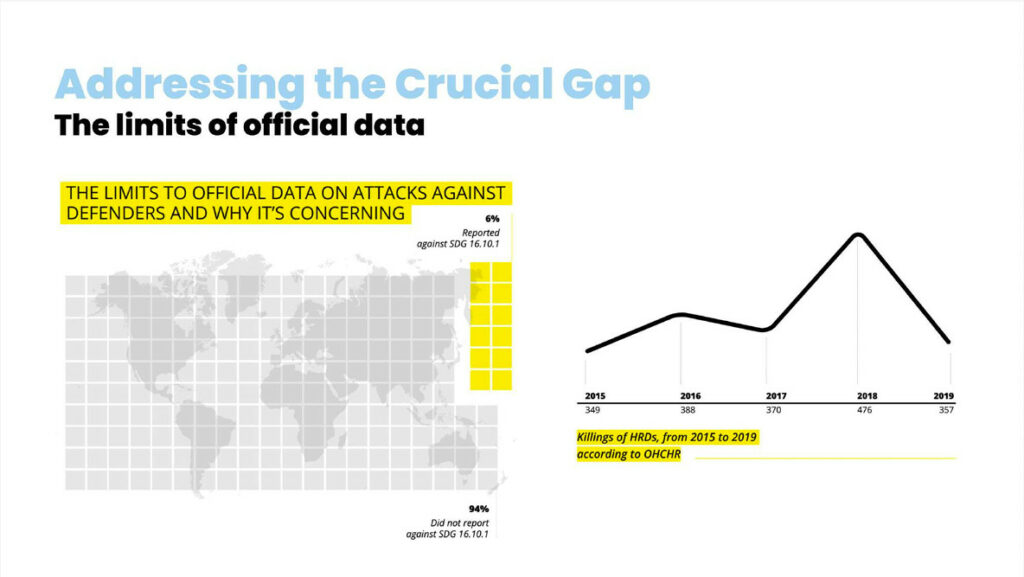
- The first thing we wanted to understand is what the official data was telling us. We knew that there are indicators, frameworks for accountability.
- SDGs indicator 16.10.1 provides one of those mechanisms for accountability but we still are seeing limited data being reported officially limited data being channeled upward through the UN.
- Of the 1,940 deaths between 2015 and 2019 reported by the UN, we don’t see those disaggregated at country level, and we cannot see land, indigenous and environmental defenders, despite estimations that they represent more than half of the cases.
- As such, we can’t see the group where we know that most of these attacks are taking place and that impairs our ability to build protection mechanisms and policies that can respond to this violence.
So what did we know we could do together. Across five pilot countries, about 20 organizations came together. We identified eight data sets that span from the global to the regional level down to community-based data collection.
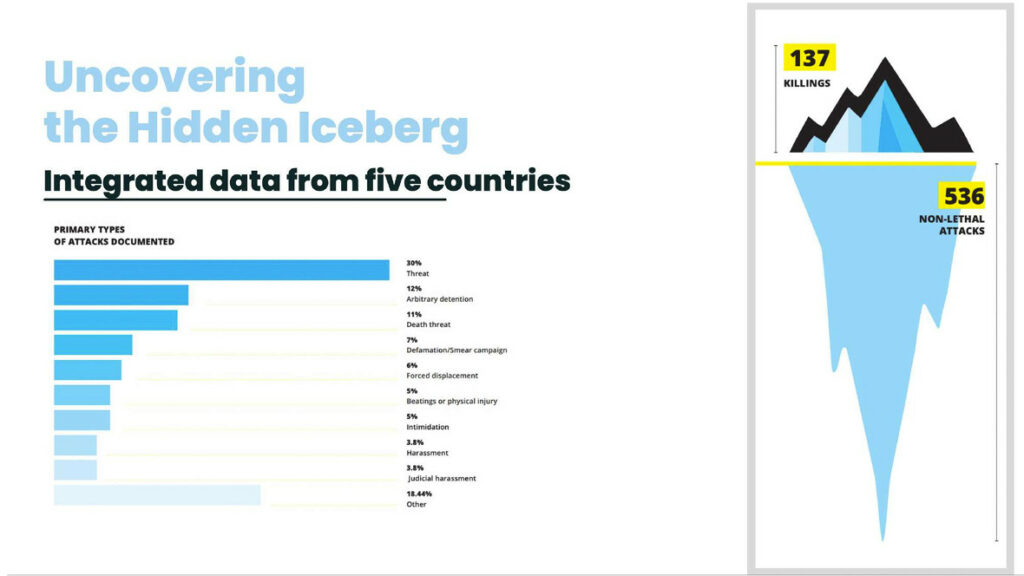
- We built a template and a methodology by which we could integrate these data sets, which meant coming up with joint definitions, joint categories and translating each of the individual data sets into a common template.
- We found that even where lethal attacks were getting the most visibility, we’re having the most attention. We see this at this hidden iceberg that we had to that that we wanted to uncover.
- We know that this is an underestimation of the non-lethal attacks that are taking place but we for the first time were able to visualize it next to this more visible, more publicized attacks and killings.
- Also working with local data collectors allowed us to see non-lethal attacks that are very hard to verify. In the bar graph, most of the attacks that we documented we’ve documented were threats that are not going to be published by media outlets.
- They are harder to verify the further you get from this from the victim themselves, so by working closely with those citizen-led data collection efforts, we were able to see these attacks that we know often serve as precedents that often indicate an impending lethal attack.
Looking forward, we are looking to work with custodians of data sets in order to make land and environmental defenders more visible. We’re working with OHCHR to integrate a definition of these land, environmental and indigenous defenders into the metadata.
We were in encouraged by the recent decision by the UN Statistical Commission to engage citizen-led data around SDGs.
We are hopeful that this kind of data integration working with community-led citizen generated documentation of attacks data can be an effective tool and one part of the Roadmap towards better protection of these defenders.
Discussion on Perspectives
Soo-Young HWANG | Legal Officer, UN Environment Programme
- The issue of environmental human defenders has been a global concern for many years, and it has not really improved. There’s a data gap, an implementation gap, and a lack of support for the environmental defenders.
- Any plan that we can push forward together with defenders, states, private sectors, and all the other UN agencies will be useful because we need coordinated efforts on this issue.
- A focal point, such as the Aarhus Convention, is a great example by having appointed a Special Rapporteur on Environmental Defenders.
- We’ve seen some progress on this and the usefulness of a focal point and a designated expert or program on this issue, which is really helping to push the agenda forward and the protection and promotion of environmental defenders.
- UNEP is working on this issue as one of its priority areas.
- We’re working internally on this but also with other UN agencies to make sure that the policy level of the issue of environmental defenders goes down to the ground level.
- We are developing — and it’s almost finalized — guidance for the UN Country teams and UN agencies on the protection of environmental defenders.
- This is to let you know that we’re making an effort at the policy level, the country level, and the practical level to support the work of environmental defenders.
Take away for 2023
Phil LYNCH | Executive Director, International Service for Human Rights
Three things are critical.
- One is the narrative, recognizing that the work of environmental human rights defenders is integral to the realization of the right to the environment.
- It therefore follows that threats, attacks, and restrictions against environmental defenders, whether they’re physical, psychological, legislative, or otherwise, should be understood as attacks on the environment itself.
- Those who are responsible for such threats and restrictions, whether unscrupulous corporations, myopic policymakers, or armed security forces, should be regarded as environmental violators and vandals.
- Legal recognition and protection are critical elements contributing to the protection of and enabling environment for environmental defenders.
- At the international level, here in Geneva, it requires that states and other stakeholders ensure that resolutions and instruments on the right to the environment explicitly recognize the integral role of environmental human rights defenders and that death threats.
- It also requires states to support the development of a comprehensive binding international treaty on business and human rights, with particular provisions on consulting with, respecting, and protecting environmental defenders.
- The final point I’d make relates to the issue of solidarity and the importance of coordination between environmental and human rights organizations at both the international and the national levels.
- Civil society mobilization and coordination around COP 27 in Egypt was essential to put human rights at the heart of the environmental justice agenda and to highlight civil society repression in the country and the ways in which that harms the environment.
- We need to build on this and ensure that COP 28 in the UAE similarly spotlights the oppression of human rights defenders, both environmental and others.
- Looking further ahead and recognizing the integral relationship between an enabling environment for civil society and a healthy environment for all, we must be resolute in demanding that major international environmental conferences never be held in repressive states with closed spaces for civil society.
